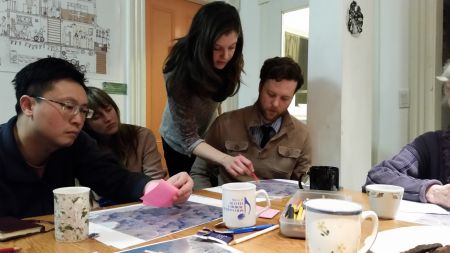Erosion is causing damage to the Halifax Regional Municipality's 400 kilometres of shoreline. But environmental activists believe that building more and more rock walls isn't the answer.
Last Thursday about a dozen volunteers attended a workshop, the first of a series, organized by the Ecology Action Centre (EAC) and Helping Nature Heal Ecological Landscaping, a company that offers solutions to counteract shoreline erosion.
The first order of business was discussing how erosion is negatively affecting Halifax shorelines and how it can be remedied in urban areas.
“Hundreds of thousands of dollars are being spent to fix things.” Helping Nature Heal president Rosmarie Lohnes told the group.
Erosion causes damage to shoreline trees by taking away the soil that anchors their roots. As the root system is exposed to oxygen, the roots die and the trees lose hold and start to tilt. In the areas where erosion is at its worst birds, animals and natural plant life is absent.
Lohnes' company is the one sent in to fix erosion problems on private properties around coastal areas, but more recently she has been working with community organizations and municipalities to do natural erosion control on a larger scale.
“When we're working on a private landholder it is just that family doing the work,” says Lohnes. “This way we can have lots of interaction and really engage that much deeper in a community kind of sense.”
Erosion is a natural process and in the case of shoreline erosion, it happens in two ways; from water coming in and from water going out.
Wave action takes away soil and sediment when it crashes against the shoreline during storms or through tidal flow. Rainwater takes away soil when it drains into the ocean from the higher ground along the shoreline.
The most widely used solution for erosion problems is to put up rock walls parallel to the shore but Lohnes and others in her field believe rock walls cause more problems than they solve.
Husband and wife oceanographer consultants Ruth Smith and Ron Loucks see a lot of rock walls near their property on the south shore and always advise against using them.
Rock walls don't slow down erosion but only deflect it around the wall, sending the erosive forces to the sides, behind and underneath the wall itself.
For one thing, that is just not fair to your neighbours, says Smith.
“It's a solution people reach for too quickly,” adds Loucks. “If one neighbour puts in the rock, the other neighbour notices the damage. Well, he says, I got to put rock in too.”
Part of reason erosion is becoming such a big problem now is the increase in storm surges and rising sea levels caused by climate change.
Living Shorelines' approach can adapt to these problems instead of HRM pouring money into quick fixes that do not help in the long run, says Robin Tress, Coastal Adaptation Coordinator at the Ecology Action Centre.
“Those processes on their own are very natural and are part of making ecosystems change and (deal with) flux,” says Tress.
The EAC and Helping Nature Heal are focusing on a small park to demonstrate the innovative approach.
Conrose Park is situated on the North West Arm, between St. Mary's Boat Club and the Waegwoltic Club. It's just a ten minute walk from Dalhousie University.
At this time the 200 square foot area is mowed regularly during the summer and fall and only contains one single species of grass.
“So what we're doing is taking this big lawn with one type of plant, grass, and turning it back into something very dynamic and diverse,” says Tess.
Native tree and plant species, as well as dead trees and driftwood are reintroduced to the landscape.
This not only addresses the erosion problem but also brings back species diversity and keeps the ecosystem healthy along the shoreline.
Bringing back these native species is very important to the project since the forest is trying to naturally come back anyway.
“We need to have that awareness that if we just let it grow, it would already do its thing and heal itself up,” says Lohnes. “If we can interject some species in there to make it come back faster than that's all the better.”
The next workshop will be on Saturday, April 11th. You can join in on this project by registering for the April 11th workshop at coastal@ecologyaction.ca. Planting day on April 25th.



